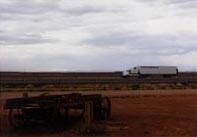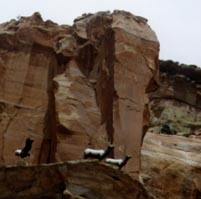

The Yellow Horse Trading Post
After we finished eating we got the car started and pulled out of Earl's parking lot to begin the drive for the day. When we got to the border of Arizona we stopped at a place called the Yellow Horse Trading post. The problem was, the only thing they were interested in trading was their Indian souvenirs for my money. I tried to trade them a "Carolina Girls: Best in the World" t-shirt for one that said "Cowboys do it in the Saddle and on top of a horse, while lassoing a steer". I made my offer and the cashier
 called over to her boss and said, "Rudy, we got another one over
here." Wendell, on the other hand, caught on to trading money for
merchandise much quicker and bought a "dream catcher." This devise
is cleaver in its use of a web of leather, beads and feathers to
capture dreams. History tells us that the Navajo used to skin
dreams and use the hides as ceremonial dress for weddings,
christenings, barmitzvas and the occasional movie premier, at
least that is the custom of the Orthodox Navajo.
called over to her boss and said, "Rudy, we got another one over
here." Wendell, on the other hand, caught on to trading money for
merchandise much quicker and bought a "dream catcher." This devise
is cleaver in its use of a web of leather, beads and feathers to
capture dreams. History tells us that the Navajo used to skin
dreams and use the hides as ceremonial dress for weddings,
christenings, barmitzvas and the occasional movie premier, at
least that is the custom of the Orthodox Navajo.
The Yellow Horse Trading post isn't an old west trading post that once exchanged food for fur. It was built in the late 1940's as the set for the Kirk Douglas film, "The Big Carnival". Along with t-shirts, dream catchers, rubber tomahawks and post cards, we found more "real live" buffalo being used to attract the vacationing element. We also found real "not-so-live" statues of animals on top of the cliffs that the Yellow Horse sits under. If you didn't look too close, or just glanced at the site as you drove past on the interstate, you might think you caught a glimpse of a bear, a doe, a buck, a ram, a cougar, and an eagle all roaming around this roadside stop.



Copyright © 2000 The Van Gogh-Goghs